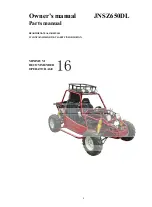
Page S-2
Repair and Service Manual
B
LIGHTNING PROTECTION AND GROUNDING
Read all of Section B and this section before attempting any procedure. Pay particular attention to Notices, Cautions, Warnings and Dangers.
GS-726-006
EFFECTIVE:
10/19/92
REVISION:
A
SUPERCEDES:
TITLE:
General Specification: Lightning Protection and Grounding
Rev -, ECN 027194
6. External Grounding Requirements
For optimum results, earth electrode installation must be accomplished early in the construction of a new site. The
earth electrode system should be established at the same time utilities are installed to insure proper interconnection of
all utility grounds/systems.
For existing sites, the earth electrode installation shall be constructed using the most economical means possible in
order to meet the intent of this specification.
Prior to the installation or design of the ground system, a survey should be taken in order to determine the earth resis-
tivity, types of soil or any man made features that may have a significant effect upon the efficiency of the grounding
system. Based on the information gathered, deviations from this specification (Exceeding normal requirements) may
be necessary in order to achieve desired results.
7. Materials
Ground Rod Electrodes: Ground rod electrodes shall have a minimum diameter of 5/8" and be no less than 10'-0" in
length. Rods may be copper, copper-clad steel or stainless steel. Galvanized steel rods are not permitted unless it is
determined that the galvanized rod will have a longer life expectancy due to soil conditions.
Ground Rod Spacing: Ground rods shall not be spaced at intervals exceeding 60'-0" around the perimeter of the struc-
ture.
Ground Loop Conductor: In no case shall the ground loop conductor be smaller than a 2/0 AWG bare, stranded, soft
drawn copper wire. The ground loop must be installed at least 24" below grade and be at least 24" away from the
structure. All bends in the conductor shall have a minimum radius of 8" and be no less than 90 degrees.
Ground Mats: In areas where electrodes cannot be driven, a ground mat consisting of a #6 solid copper or a copper-
copper clad steel mesh, utilizing a 12" x 12" cross pattern may be used. All inter-connections in the mesh shall be
brazed or silver soldered.
Ground Plates: Ground plates if utilized shall be 24" x 24" x .032" thick solid copper. Ground plates should only be
used if a ground rod cannot be driven.
Ground Connections: Unless otherwise specified or approved by the owner, all connections below grade shall be by
exothermic weld (Cadweld). Where exothermic welds may not be practical, UL approved grounding clamps that utilize
two bolts for pressure may be used. NOTE: Prior approval must be obtained in order to use a mechanical connection
below grade.
8. Earth Electrode System
The earth electrode system consists of a network of earth electrode rods, plates, mats or grids and their interconnect-
ing conductors. The extensions into the building are used as the principle grounding point for connecting to the ground
system serving the building. Ground potential is established by electrodes in the earth.
An electrode may be a metallic water pipe that has no isolation joints, a system of buried, driven rods interconnected
with a bare wire that normally forms a ring around the building or a ground plane of horizontal buried wires. Depending
upon soil conditions, building design and the existing water pipe networks, an electrode may be a combination of any
of the above mentioned systems.
9. Lightning Protection System
The lightning protection system provides a non-destructive path to ground for lightning energy contacting or induced
onto or in a building. To effectively protect from lightning damage, air terminals are installed according to the National
Fire Protection Association Lightning Protection Code (NFPA 780). Air terminals will intercept the discharge to keep it
Summary of Contents for EXPRESS L6 2012
Page 6: ...Page iv Repair and Service Manual NOTES TABLE OF CONTENTS...
Page 201: ......















































